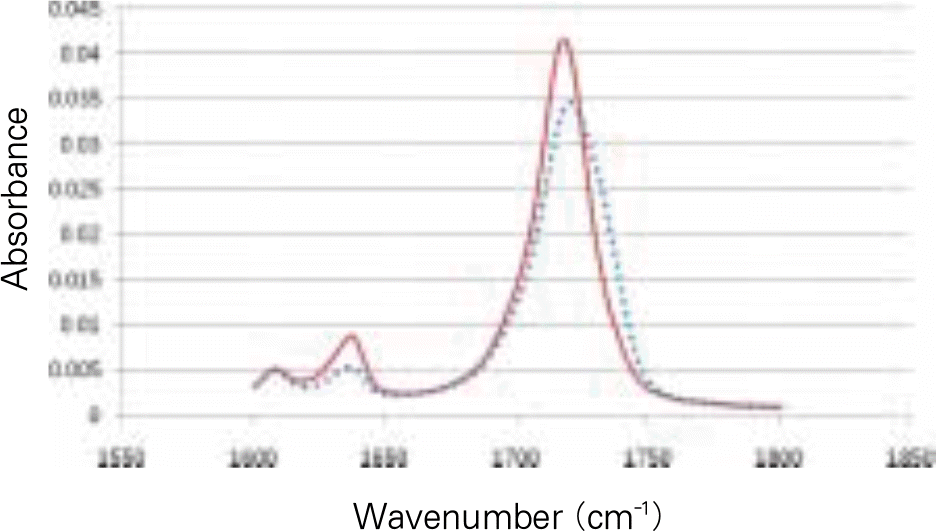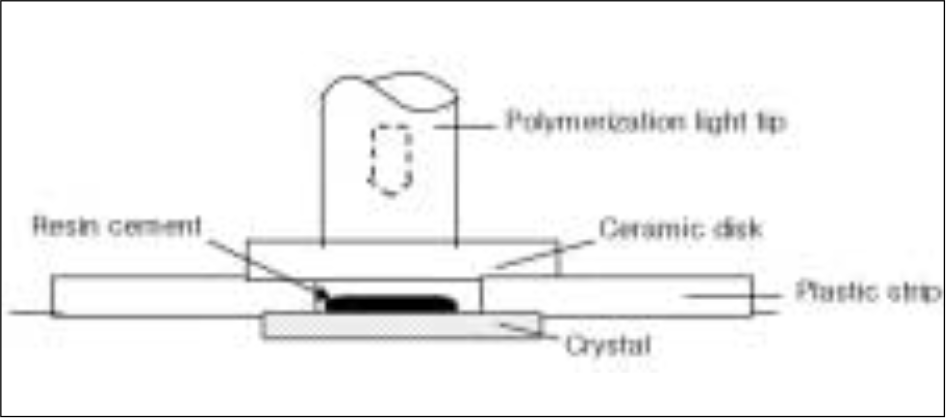Abstract
Statement of problem
The degree of light attenuation at the time of cementation of the PLV restoration depends on characteristics such as thickness, opacity and shade of the restorations, which interfere with light transmittance and, as a result, may decrease the total energy reaching the luting cement.
Purpose
The purpose of this study was to compare the degree of conversion of light-cured resin cements measuring by FT-IR in regard to different thickness, light devices and curing time.
Material and methods
In the control group, a clear slide glass (1.0 mm) was positioned between the light cured resin cement and light source. The specimens of ceramics were made with IPS Empress Esthetic. The ceramics were fabricated with varying thicknesses-0.5, 1.0, 1.5 mm with shade ETC1. Rely XTM Veneer with shade A3, light-cured resin cement, was used. Light-activation was conducted through the ceramic using a quartz tungsten halogen curing unit, a light emitting diode curing unit and a plasma arc curing unit. The degree of conversion of the light-cured resin cement was evaluated using FT-IR and OMNIC. One-way ANOVA and Tukey HSD test were used for statistical analysis (α < .05).
Results
The degree of conversion (DC) of photopolymerization using QTH and LED was higher than results of using PAC in the control group. After polymerization using QTH and LED, the DC results from the different ceramic thickness- 0.5 mm, 1.0 mm, 1.5 mm- did not show a significant difference when compared with those of control group. However, the DC for polymerization using PAC in the 1.5mm ceramic group showed significantly lower DC than those of the control group and 0.5 mm ceramic group (P < .05). At 80 s and 160 s, the DC of light-cured resin cement beneath 1.0 mm ceramic using LED was significantly higher than at 20 s (P < .05).
Conclusion
Within the limitation of this study, when adhering PLV to porcelain with a thickness between 0.5 - 1.5 mm, the use of PAC curing units were not considered however, light cured resin cements were effective when cured for over 40 seconds with QTH or LED curing units. Also, when curing the light cured resin cements with LED, the degree of polymerization was not proportional with the curing time. Curing exceeding a certain curing time, did not significantly affect the degree of polymerization. (J Korean Acad Prosthodont 2009;47:416-23)
Go to : 
REFERENCES
1.Fradeani M. Six-year follow-up with Empress veneers. Int J Periodontics Restorative Dent. 1998. 18:216–25.
2.Fradeani M., Redemagni M., Corrado M. Porcelain laminate veneers: 6- to 12-year clinical evaluation-a retrospective study. Int J Periodontics Restorative Dent. 2005. 25:9–17.
3.el-Mowafy OM., Rubo MH., el-Badrawy WA. Hardening of new resin cements cured through a ceramic inlay. Oper Dent. 1999. 24:38–44.
4.Blackman R., Barghi N., Duke E. Influence of ceramic thickness on the polymerization of light-cured resin cement. J Prosthet Dent. 1990. 63:295–300.

5.Strang R., Macdonald I., O' Hagan S., Murray J., Stephen KW. Variations in performance of curing light units by determination of composite resin setting time. Br Dent J. 1987. 162:63–5.

6.Nathanson D. Etched porcelain restorations for improved esthetics, part II: Onlays. Compendium. 1987. 8:105–10.
7.Rasetto FH., Driscoll CF., Prestipino V., Masri R., von Fraunhofer JA. Light transmission through all-ceramic dental materials: a pilot study. J Prosthet Dent. 2004. 91:441–6.

8.Uctasli S., Hasanreisoglu U., Wilson HJ. The attenuation of radiation by porcelain and its effect on polymerization of resin cements. J Oral Rehabil. 1994. 21:565–75.

9.Myers ML., Caughman WF., Rueggeberg FA. Effect of restoration composition, shade, and thickness on the cure of a photoactivated resin cement. J Prosthodont. 1994. 3:149–57.

10.Nathanson D., Banasr F. Color stability of resin cements—an in vitro study. Pract Proced Aesthet Dent. 2002. 14:449–55.
11.Calamia JR., Calamia CS. Porcelain laminate veneers: reasons for 25 years of success. Dent Clin North Am. 2007. 51:399–417.

12.Asmussen E. Restorative resins: hardness and strength vs. quantity of remaining double bonds. Scandinavian J Dent Res. 1982. 90:484–9.

13.Pianelli C., Devaux J., Bebelman S., Leloup G. The micro-Raman spectroscopy, a useful tool to determine the degree of conversion of light- activated composite resins. J Biome Mater Res. 1999. 48:675–81.
14.Jung H., Friedl KH., Hiller KA., Haller A., Schmalz G. Curing efficiency of different polymerization methods through ceramic restorations. Clin Oral Investig. 2001. 5:156–61.

15.Koch A., Kroeger M., Hartung M., Manetsberger I., Hiller KA., Schmalz G., Friedl KH. Influence of ceramic translucency on curing efficacy of different light-curing units. J Adhes Dent. 2007. 9:449–62.
16.Tango RN., Sinhoreti MA., Correr AB., Correr-Sobrinho L., Henriques GE. Effect of light-curing method and cement activation mode on resin cement knoop hardness. J Prosthodont. 2007. 16:480–4.

17.Borges GA., Agarwal P., Miranzi BA., Platt JA., Valentino TA., dos Santos PH. Influence of different ceramics on resin cement Knoop Hardness Number. Oper Dent. 2008. 33:622–8.

18.Matsumoto H., Gres JE., Marker VA., Okabe T., Ferracane JL., Harvey GA. Depth of cure of visible light-cured resin: clinical simulation. J Prosthet Dent. 1986. 55:574–8.

19.Rueggeberg FA., Craig RG. Correlation of parameters used to estimate monomer conversion in a light-cured composite. J Dent Res. 1988. 67:932–7.

20.DeWald JP., Ferracane JL. A comparison of four modes of evaluating depth of cure of light-activated composites. J Dent Res. 1987. 66:727–30.

21.Pazin MC., Moraes RR., Goncalves LS., Borges GA., Sinhoreti MA., Correr-Sobrinho L. Effects of ceramic thickness and curing unit on light transmission through leucite-reinforced material and polymerization of dual-cured luting agent. J Oral Sci. 2008. 50:131–6.

22.Moraes RR., Brandt WC., Naves LZ., Correr-Sobrinho L., Piva E. Light- and time-dependent polymerization of dual-cured resin luting agent beneath ceramic. Acta Odontol Scand. 2008. 66:257–61.

23.Feng L., Carvalho R., Suh BI. Insufficient cure under the condition of high irradiance and short irradiation time. Dent Mater. 2009. 25:283–9.

24.Woo YS., Kim S. A study on the mode of polymerization of light-cured restorative materials cured with plasma arc light curing unit. J Korean Acad Pediatr Dent. 2002. 29:262–9.
25.Pascal Magne UB. Bonded porcelain restorations in the anterior dentition. Quintessence Publishing Co. Inc;2002. p. 242–7.
26.Peutzfeldt A., Sahafi A., Asmussen E. Characterization of resin composites polymerized with plasma arc curing units. Dent Mater. 2000. 16:330–6.

27.Feilzer AJ., Dooren LH., de Gee AJ., Davidson CL. Influence of light intensity on polymerization shrinkage and integrity of restoration-cavity interface. Eur J Oral Sci. 1995. 103:322–6.

28.Maffezzoli A., Della Pietra A., Rengo S., Nicolais L., Valletta G. Photopolymerization of dental composite matrices. Biomaterials. 1994. 15:1221–8.

29.Asmussen E. Softening of BISGMA-based polymers by ethanol and by organic acids of plaque. Scand J Dent Res. 1984. 92:257–61.

30.Ruyter IE., Svendsen SA. Remaining methacrylate groups in composite restorative materials. Acta Odontol Scand. 1978. 36:75–82.

31.Klaiber B., Schubert K., Hugo B., Hofmann N. Comparison between a plasma arc light source and conventional halogen curing units regarding flexural strength, modulus, and hardness of photoactivated resin composites. Clin Oral Investig. 2000. 4:140–7.
Go to : 
 | Fig. 2.FT-IR spectra before (solid-line) and after (dotted-line) photopolymerization (an example from group Q10). |
Table I.
Description of the curing devices used in this study
| Light source | Unit | Curing time (sec.) | Intensity (mw/cm2) | Manufacturer |
|---|---|---|---|---|
| QTH | 3M Curing LightXL3000 | 40∗ | 600 | 3M ESPE, St. Paul, MN, USA |
| LED | EliparTM FreeLight2 | 40∗ | 600 | 3M ESPE, Seefeld, Germany |
| PAC | Flipo | 6† | 1900 | LOKKI, Lyon, France |
Table II.
Description of the experimental groups used in this study
Table III.
Results of two-way ANOVA for degree of conversion
| Sum of squares | Df | Mean square | F | P | |
|---|---|---|---|---|---|
| Light | 4048.477 | 2 | 2024.239 | 91.996 | .000 |
| Thickness | 335.191 | 3 | 111.73 | 5.078 | .002 |
| Light ∗ thickness | 162.42 | 6 | 27.07 | 1.23 | .295 |
| Error | 2904.471 | 132 | 22.004 | ||
| Total 2 | 256420.8 | 144 | |||
| Corrected total | 7450.559 | 143 |
Table IV.
Comparison of DC values (%) among groups according to ceramic thickness and light source




 PDF
PDF ePub
ePub Citation
Citation Print
Print



 XML Download
XML Download